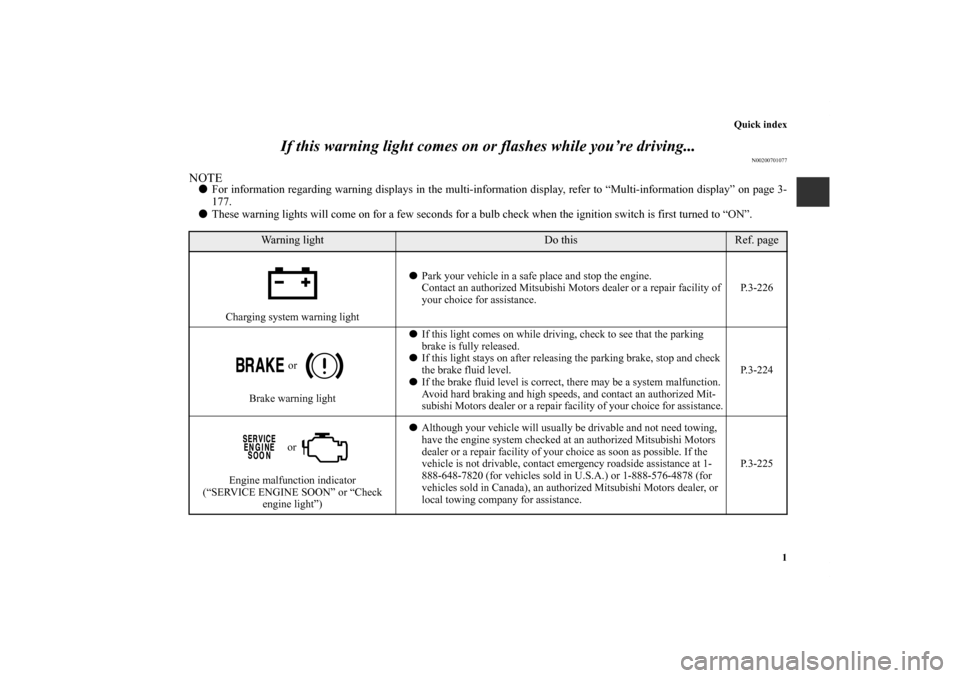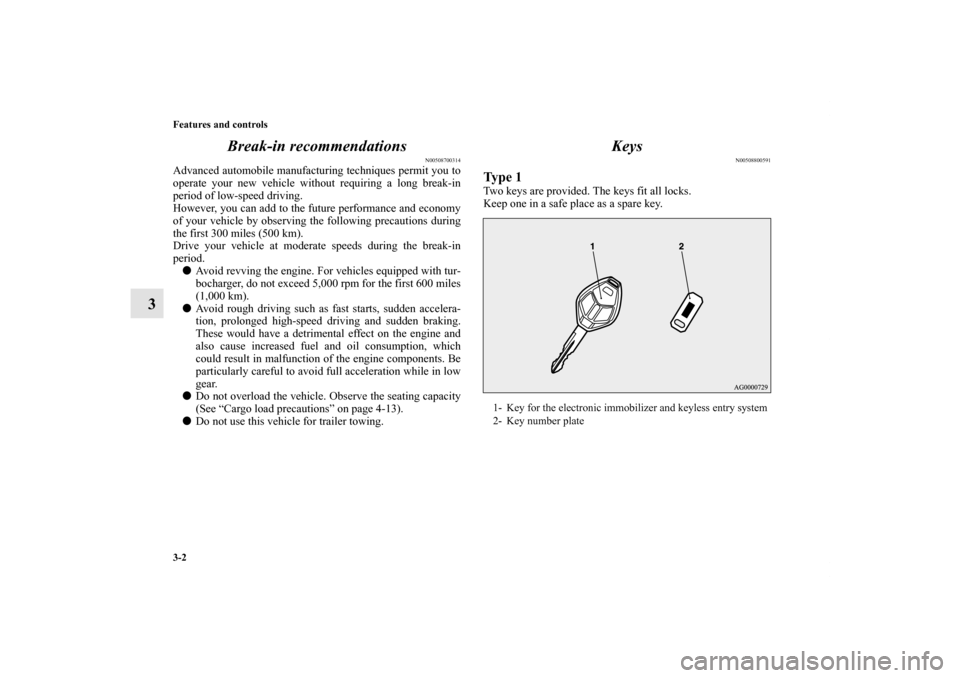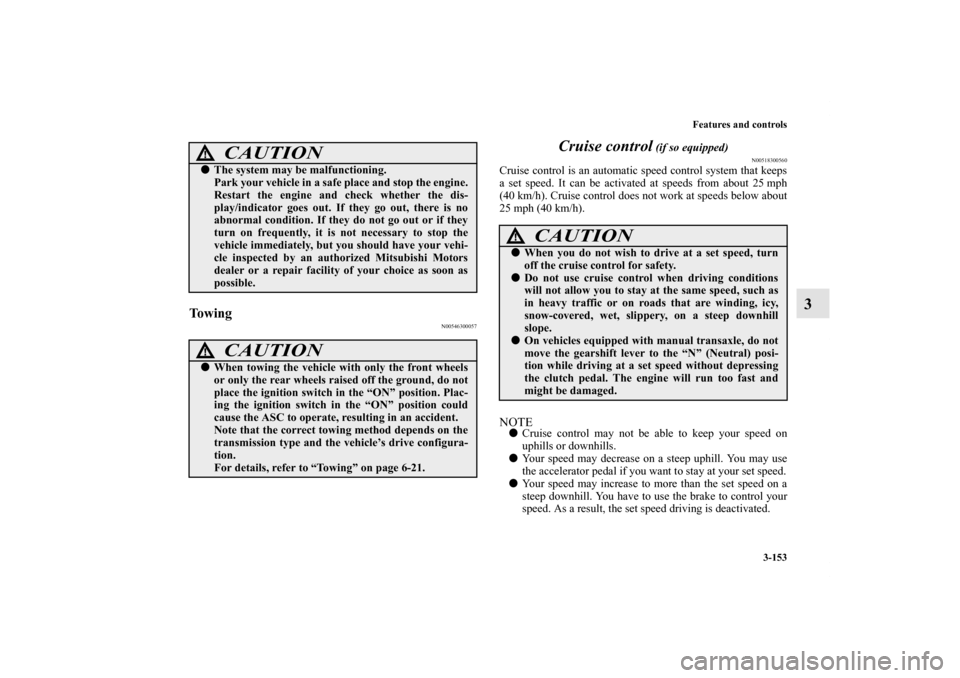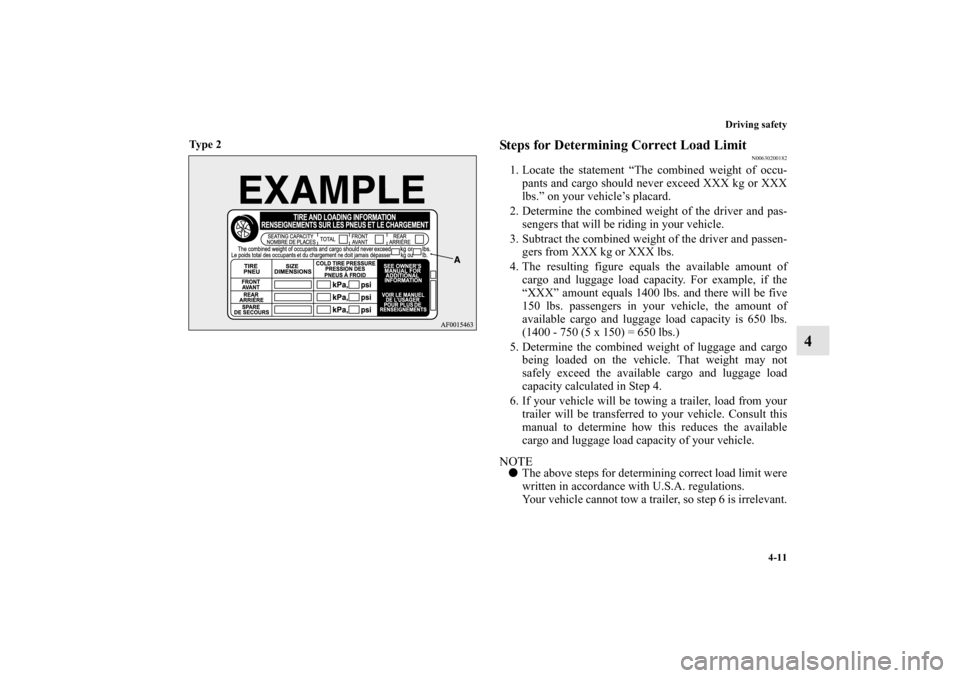Page 12 of 706

Quick index
1
If this warning light comes on or flashes while you’re driving...
N00200701077
NOTE�For information regarding warning displays in the multi-information display, refer to “Multi-information display” on page 3-
177.
�These warning lights will come on for a few seconds for a bulb check when the ignition switch is first turned to “ON”.
Warning light
Do this
Ref. page
Charging system warning light�Park your vehicle in a safe place and stop the engine.
Contact an authorized Mitsubishi Motors dealer or a repair facility of
your choice for assistance.P.3-226
or
Brake warning light�If this light comes on while driving, check to see that the parking
brake is fully released.
�If this light stays on after releasing the parking brake, stop and check
the brake fluid level.
�If the brake fluid level is correct, there may be a system malfunction.
Avoid hard braking and high speeds, and contact an authorized Mit-
subishi Motors dealer or a repair facility of your choice for assistance.P.3-224
or
Engine malfunction indicator
(“SERVICE ENGINE SOON” or “Check
engine light”)�Although your vehicle will usually be drivable and not need towing,
have the engine system checked at an authorized Mitsubishi Motors
dealer or a repair facility of your choice as soon as possible. If the
vehicle is not drivable, contact emergency roadside assistance at 1-
888-648-7820 (for vehicles sold in U.S.A.) or 1-888-576-4878 (for
vehicles sold in Canada), an authorized Mitsubishi Motors dealer, or
local towing company for assistance.P.3-225
BK0151000US.book 1 ページ 2012年3月29日 木曜日 午後6時8分
Page 16 of 706
Quick index
5
Problem
Do this
Ref. page
The engine coolant tempera-
ture display “ ” in the multi-
information display is flashing.
Steam comes out of the engine
compartment.
Ty p e 1
Ty p e 2The engine is overheated.
Carefully stop the vehicle in a safe place.P. 6 - 5
The vehicle is stuck in sand,
mud, or snow.Rock your vehicle back and forth to free it. P.6-23
WA R N I N G
!�When attempting to rock your vehicle out of a stuck position, be sure that no one is near the vehicle. The rocking
motion may cause the vehicle to suddenly lurch forward or backward, possibly injuring bystanders.�Avoid revving the engine or spinning the wheels. Prolonged efforts to free a stuck vehicle may result in overheating
and transaxle failure.
If the vehicle remains stuck after several rocking attempts, have a towing service pull the vehicle out.
BK0151000US.book 5 ページ 2012年3月29日 木曜日 午後6時8分
Page 95 of 706

3-2 Features and controls
3Break-in recommendations
N00508700314
Advanced automobile manufacturing techniques permit you to
operate your new vehicle without requiring a long break-in
period of low-speed driving.
However, you can add to the future performance and economy
of your vehicle by observing the following precautions during
the first 300 miles (500 km).
Drive your vehicle at moderate speeds during the break-in
period.
�Avoid revving the engine. For vehicles equipped with tur-
bocharger, do not exceed 5,000 rpm for the first 600 miles
(1,000 km).
�Avoid rough driving such as fast starts, sudden accelera-
tion, prolonged high-speed driving and sudden braking.
These would have a detrimental effect on the engine and
also cause increased fuel and oil consumption, which
could result in malfunction of the engine components. Be
particularly careful to avoid full acceleration while in low
gear.
�Do not overload the vehicle. Observe the seating capacity
(See “Cargo load precautions” on page 4-13).
�Do not use this vehicle for trailer towing.
Keys
N00508800591
Ty p e 1Two keys are provided. The keys fit all locks.
Keep one in a safe place as a spare key.1- Key for the electronic immobilizer and keyless entry system
2- Key number plate
BK0151000US.book 2 ページ 2012年3月29日 木曜日 午後6時8分
Page 228 of 706
Features and controls
3-135
3
Towing Jacking up all-wheel drive vehicles
CAUTION
!�Do not tow all-wheel drive vehicles with the front or
rear wheels on the ground (Type A or Type B) as
illustrated. This could result in damage to the driv-
etrain, or unstable towing.
If you tow all-wheel drive vehicles, use Type C or
Type D equipment.
WA R N I N G
!�Do not start or run the engine while the vehicle is on
the jack. The jack could slip out of position and
result in an accident.
BK0151000US.book 135 ページ 2012年3月29日 木曜日 午後6時8分
Page 246 of 706

Features and controls
3-153
3
To w i n g
N00546300057
Cruise control
(if so equipped)
N00518300560
Cruise control is an automatic speed control system that keeps
a set speed. It can be activated at speeds from about 25 mph
(40 km/h). Cruise control does not work at speeds below about
25 mph (40 km/h).NOTE�Cruise control may not be able to keep your speed on
uphills or downhills.
�Your speed may decrease on a steep uphill. You may use
the accelerator pedal if you want to stay at your set speed.
�Your speed may increase to more than the set speed on a
steep downhill. You have to use the brake to control your
speed. As a result, the set speed driving is deactivated.
CAUTION
!�The system may be malfunctioning.
Park your vehicle in a safe place and stop the engine.
Restart the engine and check whether the dis-
play/indicator goes out. If they go out, there is no
abnormal condition. If they do not go out or if they
turn on frequently, it is not necessary to stop the
vehicle immediately, but you should have your vehi-
cle inspected by an authorized Mitsubishi Motors
dealer or a repair facility of your choice as soon as
possible.
CAUTION
!�When towing the vehicle with only the front wheels
or only the rear wheels raised off the ground, do not
place the ignition switch in the “ON” position. Plac-
ing the ignition switch in the “ON” position could
cause the ASC to operate, resulting in an accident.
Note that the correct towing method depends on the
transmission type and the vehicle’s drive configura-
tion.
For details, refer to “Towing” on page 6-21.
CAUTION
!�When you do not wish to drive at a set speed, turn
off the cruise control for safety.�Do not use cruise control when driving conditions
will not allow you to stay at the same speed, such as
in heavy traffic or on roads that are winding, icy,
snow-covered, wet, slippery, on a steep downhill
slope.�On vehicles equipped with manual transaxle, do not
move the gearshift lever to the “N” (Neutral) posi-
tion while driving at a set speed without depressing
the clutch pedal. The engine will run too fast and
might be damaged.
BK0151000US.book 153 ページ 2012年3月29日 木曜日 午後6時8分
Page 398 of 706
4
Driving safety
Fuel economy . . . . . . . . . . . . . . . . . . . . . . . . . . . . .4- 2
Driving, alcohol and drugs. . . . . . . . . . . . . . . . . . .4- 2
Floor mat . . . . . . . . . . . . . . . . . . . . . . . . . . . . . . . .4- 3
Vehicle preparation before driving. . . . . . . . . . . . .4- 5
Safe driving techniques . . . . . . . . . . . . . . . . . . . . .4- 6
Driving during cold weather . . . . . . . . . . . . . . . . .4- 6
Braking. . . . . . . . . . . . . . . . . . . . . . . . . . . . . . . . . .4- 7
Parking . . . . . . . . . . . . . . . . . . . . . . . . . . . . . . . . . .4- 8
Loading information . . . . . . . . . . . . . . . . . . . . . . .4- 9
Cargo loads . . . . . . . . . . . . . . . . . . . . . . . . . . . . . .4- 13
Trailer towing. . . . . . . . . . . . . . . . . . . . . . . . . . . . .4- 16
BK0151000US.book 1 ページ 2012年3月29日 木曜日 午後6時8分
Page 408 of 706

Driving safety
4-11
4
Ty p e 2
Steps for Determining Correct Load Limit
N00630200182
1. Locate the statement “The combined weight of occu-
pants and cargo should never exceed XXX kg or XXX
lbs.” on your vehicle’s placard.
2. Determine the combined weight of the driver and pas-
sengers that will be riding in your vehicle.
3. Subtract the combined weight of the driver and passen-
gers from XXX kg or XXX lbs.
4. The resulting figure equals the available amount of
cargo and luggage load capacity. For example, if the
“XXX” amount equals 1400 lbs. and there will be five
150 lbs. passengers in your vehicle, the amount of
available cargo and luggage load capacity is 650 lbs.
(1400 - 750 (5 x 150) = 650 lbs.)
5. Determine the combined weight of luggage and cargo
being loaded on the vehicle. That weight may not
safely exceed the available cargo and luggage load
capacity calculated in Step 4.
6. If your vehicle will be towing a trailer, load from your
trailer will be transferred to your vehicle. Consult this
manual to determine how this reduces the available
cargo and luggage load capacity of your vehicle.NOTE�The above steps for determining correct load limit were
written in accordance with U.S.A. regulations.
Your vehicle cannot tow a trailer, so step 6 is irrelevant.
BK0151000US.book 11 ページ 2012年3月29日 木曜日 午後6時8分
Page 413 of 706
4-16 Driving safety
4
Refitting the covers1. With each cover, put the tabs (C) on the cover in the holes
(D) in the roof.
2. Slide the cover (B) toward the rear of the vehicle to install
it.
Trailer towing
N00629800188
WA R N I N G
!�Do not use this vehicle for trailer towing. It may not
be possible to maintain control or adequate braking.
BK0151000US.book 16 ページ 2012年3月29日 木曜日 午後6時8分